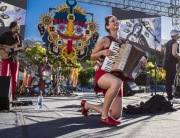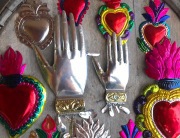International Folk Art Alliance Announces the Finalists of the Second Annual Living Traditions and Community Impact Awards
Saturday, July 15, 2017
Santa Fe, New Mexico—The International Folk Art Alliance’s second annual One World Awards will recognize life-long contributions and commitments to the creation and support of folk art in a special event held at La Fonda on the Plaza, Lumpkins Ballroom on July 15, during the 2017 International Folk Art Market | Santa Fe.
The International Folk Art Alliance and its flagship program, the International Folk Art Market | Santa Fe, will recognize the artists, supporters, organizations, and advocates that embody the mission of the International Folk Art Alliance (IFAA), which celebrates and preserves living folk art traditions and creates economic opportunities for and with folk artists worldwide.
The Living Traditions Award
The Living Tradition Award honors artists who are extraordinary examples of IFAA’s mission by contributing to the preservation of culture through reviving and strengthening a traditional folk art with a strategy for passing it on to future generations. The Finalists are:
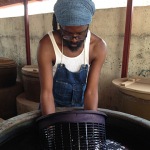 Aboubakar Fofana spent several years working in Paris as a calligrapher and graphic designer but was always drawn back to his native Mali, and to the depth and beauty of indigo. He began to return regularly to West Africa to undertake an apprenticeship in indigo dyeing. His passion for traditional West African textiles grew from traveling around the continent to speak to his expert elders. From these experiences, he began to feel an urgency to preserve the use of indigo and to revive the growth of biological indigo and of organic cotton in West Africa, particularly in Mali.
Aboubakar Fofana spent several years working in Paris as a calligrapher and graphic designer but was always drawn back to his native Mali, and to the depth and beauty of indigo. He began to return regularly to West Africa to undertake an apprenticeship in indigo dyeing. His passion for traditional West African textiles grew from traveling around the continent to speak to his expert elders. From these experiences, he began to feel an urgency to preserve the use of indigo and to revive the growth of biological indigo and of organic cotton in West Africa, particularly in Mali.
After winning the prestigious Villa Medicis Hors les Murs fellowship, his project ‘Sublime Indigo – Japan-France-Mali’, took him to Japan to study, and back again to Mali, where his atelier took shape. Ever since, Aboubakar has followed his passion for the textile arts, with a particular focus on increasingly rare techniques of natural indigo and mud dyeing native to his birthplace. His original passion for calligraphy still emerges in his textile work, especially in the medium of mud dyeing.
 Abdullah and Abduljabbar Khatri of India were born into a family of traditional tie-dye artists, but their ancestral lineage with the art form was broken by their great-grandfather. Drawn back toward this traditional Kutchi craft, the brothers took advantage of the knowledge of uncles and cousins who still make bandhani to reinvigorate the family business.
Abdullah and Abduljabbar Khatri of India were born into a family of traditional tie-dye artists, but their ancestral lineage with the art form was broken by their great-grandfather. Drawn back toward this traditional Kutchi craft, the brothers took advantage of the knowledge of uncles and cousins who still make bandhani to reinvigorate the family business.
The brothers experimented with new fabrics and designs for their tie-dyed textiles, merging traditional and contemporary motifs. From naturally dyed indigo cotton bandhani shawls to Habuti silk dupattas (long, multipurpose scarves traditional to India), their work has won awards and international acclaim. The bandhani technique involves dyeing a fabric that is tied tightly with a thread at specific points. Thousands of these tiny knots, known as bheendi, can appear on a meter of fabric, forming a vast variety of patterns. The design emerges after dyeing, when the knots are untied to reveal galaxies of dots, often in bright colors on rich backgrounds.
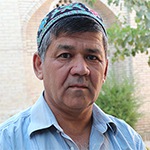 Fattillo Kendjaev of Uzbekistan was drawn to silk carpet designs from the Timurid Era (1370-1507), one of Islamic Art’s most brilliant periods. When he learned many old patterns had been lost, he copied carpet designs depicted in antique miniature paintings and recreated them with traditional weaving methods and natural dyes. Firuza Khamraeva, Fattillo’s wife, is also a master weaver and dyer. She works with Fattillo at his Carpet Weaving Training School, where she teaches, develops designs, and assists with dyeing. She is also a master of suzani embroidery.
Fattillo Kendjaev of Uzbekistan was drawn to silk carpet designs from the Timurid Era (1370-1507), one of Islamic Art’s most brilliant periods. When he learned many old patterns had been lost, he copied carpet designs depicted in antique miniature paintings and recreated them with traditional weaving methods and natural dyes. Firuza Khamraeva, Fattillo’s wife, is also a master weaver and dyer. She works with Fattillo at his Carpet Weaving Training School, where she teaches, develops designs, and assists with dyeing. She is also a master of suzani embroidery.
In creating the dyes for the carpets, Fattillo asks vegetable sellers to save their yellow onion skins, arranges for walnut hulls to be collected in the mountains, obtains madder root in Afghanistan, and purchases indigo and cochineal from India. Achieving consistent colors between dye baths is a challenge. Pomegranate skins and apple, grape, and mulberry leaves yield different colors as soil, sun, and temperature conditions change across the seasons. Dyes mixed in large copper pots are used twice, first for dyeing the intense colors needed for carpets, and second for the softer colors in suzani. To avoid Uzbekistan’s scorching summers and chilling winters, dyeing takes place in the spring and autumn.
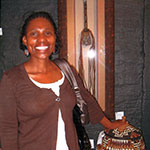 Angeline Bonisiwe Masuku of South Africa learned to weave from her aunt and now supports her family with the art. She passed her weaving skills on to her younger sister and daughter, and to many other women in her village, helping them to create a path out of poverty.
Angeline Bonisiwe Masuku of South Africa learned to weave from her aunt and now supports her family with the art. She passed her weaving skills on to her younger sister and daughter, and to many other women in her village, helping them to create a path out of poverty.
Angeline weaves traditional ilala palm baskets that are used for daily life as well as for decoration. After gathering the ilala palm, Angeline then uses leaves and roots to create natural dyes and weaves the materials in traditional shapes. She designs her baskets to incorporate imagery of her immediate environment, as well as the geometric designs from Zulu beadwork.
 Ben-Zion Davis from Israel uses traditional tools to shape sterling silver, semi-precious stones, lava, coral, and archaeological artifacts into filigree jewelry of all sorts, including ceremonial items that have been used for centuries. For hundreds of years, Yemenite Jews have maintained a closely guarded tradition of jewelry-making using precious metals. Their tools and techniques have been passed down as family secrets, protecting a heritage and a livelihood that has constituted a special social identity for Yemenite Jews.
Ben-Zion Davis from Israel uses traditional tools to shape sterling silver, semi-precious stones, lava, coral, and archaeological artifacts into filigree jewelry of all sorts, including ceremonial items that have been used for centuries. For hundreds of years, Yemenite Jews have maintained a closely guarded tradition of jewelry-making using precious metals. Their tools and techniques have been passed down as family secrets, protecting a heritage and a livelihood that has constituted a special social identity for Yemenite Jews.
The art has been a prominent part of Ben-Zion’s family for eight generations. At the age of ten he began helping his father by preparing and interweaving silver threads. “I am still using ancient methods to make jewelry, maybe more advanced than my grandfather’s, but not very modern,” says Ben-Zion.
The Community Impact Award
The Community Impact Award honors artists who are extraordinary examples of IFAA’s mission by positively impacting social change in their community. The finalists are:
Self Help Enterprise (SHE), based in India, has more than 800 artists making kantha embroidery — a centuries-old technique of sewing layers of old fabric together. Women sit and sew together, as they have for generations. Kantha is appreciated for its unmatched beauty and is integral to the cultural heritage of Bengal.
SHE reinvigorated the art of kantha with contemporary colors and geometric patterns while drawing from classic designs of village vignettes and images of gods and goddesses for inspiration. Women sit and sew together, as they have for generations. Kantha is appreciated for its unmatched beauty and is the cultural heritage of Bengal. SHE products include scarves, shawls, and garments, as well as bedspreads, cushion covers, and table linens. Through sales of kantha, SHE artists are able to express themselves and tell a unique story. They are also able to earn year-round incomes which improve the lives of artists and their families.
Sna Jolobil, which means “the weavers house,”was founded about 30 years ago by Pedro Meza, a Tenejapa weaver from Mexico, and Walter ‘Chip’ Morris, who wrote Living Maya. The organization currently includes 800 weavers from 20 Tzotzil and Tzeital indigenous communities in the Mexican state of Chiapas. Sna Jolobil aims to preserve traditional design and technique through the study of historical and ancient textiles. Thanks to sales of their art, members of the cooperative are able to pay for medical needs, school supplies, and more.
Pedro Meza’s traditional brocade designs date back to the year 600 and have been featured in ceremonial dress since the Classical Maya era. He and the weavers in his cooperative use back strap looms and finish each piece with colorful embroidery. The Maya women in highland Chiapas wear hand woven clothing nearly every day, with more ornate items being worn for special occasions. For men, traditional dress is associated with festivals and religious ceremonies. Some of Pedro’s weavings are replicas of ancient textiles that were reproduced from sculptures.
A difficult childhood forced Somporn Intaraprayong to become self-sufficient, but she also acquired great empathy — especially towards women who have struggled to provide for themselves and their children. As a textile artist, Somporn is self-taught and she has taken her creativity, passion, and discipline across various regions in Thailand to teach women to sew clothing and accessories by hand using traditional techniques and stitches.
Ampornpun Tongchai, also from Thailand, learned to sew, weave, and dye from her mother and grandmother. At her cooperative in the northeast part of the country, she and other weavers use natural dyes like indigo, tamarind, and mango leaf in their weavings. Both the sewn items and the weavings have become a way to improve the lives of the seamstresses and weavers, but they also embody tradition and cultural identity and foster a sense of unity and community. Perhaps best of all, the work helps support families and provide education for their children.
The artists of Sulafa Embroidery Centre create textiles filled with traditional Palestinian motifs and patterns. Designs include cypress trees, flowers, tents, and the Hajem, the symbol offering protection from the evil eye. Traditional embroidery work utilizes a variety of techniques to create not simply beautiful decoration but illuminate subjects and themes that are integral to the women’s lives.
Cross-stitch and other techniques are still learned at home, taught by older generations, passed from mother to daughter. The sewing of cross-stitch is relatively simple, but making a large patterned piece in this fashion requires great perseverance, skill, and accuracy, and takes years to perfect.
Embroidery plays a central role in these women’s lives, providing not only income but also an opportunity to meet and share their experiences and to perpetuate Palestinian culture. The embroidery provides income to approximately 350 women and their families.
The United Relief and Works Agency for Palestinian Refugees in the Near East (UNRWA) has for 60 years operated the Sulafa Embroidery Centre to help refugee women earn an income through the production and sale of their embroidered goods.
El Grupo Bayate is composed of a group of city painters from Cuba who joined together 20 years ago in hopes of preserving their cultural identity through paintings and public murals. El Grupo Bayate teaches art classes to children and organizes community art projects. They hope that their art will create a sense of pride and belonging within their community and promote awareness about the roots and history of painting in their town.
Luis Joaquin Rodriguez Arias is a self-taught painter who has passed on this painting tradition to his son, known as “El Estudiante.” Along with six other members of El Grupo Bayate, they create works that feature the daily life of their community.
All award recipients will be announced and celebrated at the One World Awards Dinner, Saturday, July 15, 2017 at La Fonda on the Plaza
The International Folk Art Market | Santa Fe’s One World Awards Dinner will be held Saturday, July 15, Friday, from 6:30-9:00pm, at La Fonda on the Plaza, Lumpkins Ballroom. The event is sold out. For detailed information and schedule of events, visit 172.97.101.154.
For more information, interview requests, and photos, please contact Clare Hertel at 505-474-6783 or clare@clarehertelcommunications.com.


